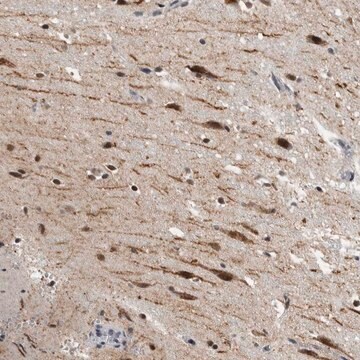MABF3171
Anti-CXCR7 Antibody, clone 10D1
Sinónimos:
Atypical chemokine receptor 3, C-X-C chemokine receptor type 7, CXC-R7, CXCR-7, Chemokine orphan receptor 1, G-protein coupled receptor 159, G-protein coupled receptor RDC1 homolog, RDC-1
About This Item
Productos recomendados
origen biológico
mouse
Nivel de calidad
forma del anticuerpo
purified antibody
tipo de anticuerpo
primary antibodies
clon
10D1, monoclonal
reactividad de especies
human
envase
antibody small pack of 100
técnicas
flow cytometry: suitable
inhibition assay: suitable
isotipo
IgG2a
secuencia del epítopo
Extracellular domain
Nº de acceso Protein ID
Nº de acceso UniProt
Información sobre el gen
human ... ACKR3(57007)
Especificidad
Inmunógeno
Aplicación
Evaluated by Flow Cytometry in Raji cells.
Flow Cytometry Analysis: 1 µg of this antibody detected CXCR7 in one million Raji cells.
Tested Applications
Inhibition Assay: A representative lot inhibited the binding to the principal ligand CXCL12 to CXCR7. (Patent ID: WO2010141986A1).
Flow Cytometry Analysis: A representative lot detected CXCR7 in Flow Cytometry applications (Patent ID: WO2010141986A1).
Note: Actual optimal working dilutions must be determined by end user as specimens, and experimental conditions may vary with the end user
Descripción de destino
Forma física
Reconstitución
Almacenamiento y estabilidad
Otras notas
Cláusula de descargo de responsabilidad
¿No encuentra el producto adecuado?
Pruebe nuestro Herramienta de selección de productos.
Código de clase de almacenamiento
12 - Non Combustible Liquids
Clase de riesgo para el agua (WGK)
WGK 2
Punto de inflamabilidad (°F)
Not applicable
Punto de inflamabilidad (°C)
Not applicable
Certificados de análisis (COA)
Busque Certificados de análisis (COA) introduciendo el número de lote del producto. Los números de lote se encuentran en la etiqueta del producto después de las palabras «Lot» o «Batch»
¿Ya tiene este producto?
Encuentre la documentación para los productos que ha comprado recientemente en la Biblioteca de documentos.
Nuestro equipo de científicos tiene experiencia en todas las áreas de investigación: Ciencias de la vida, Ciencia de los materiales, Síntesis química, Cromatografía, Analítica y muchas otras.
Póngase en contacto con el Servicio técnico








